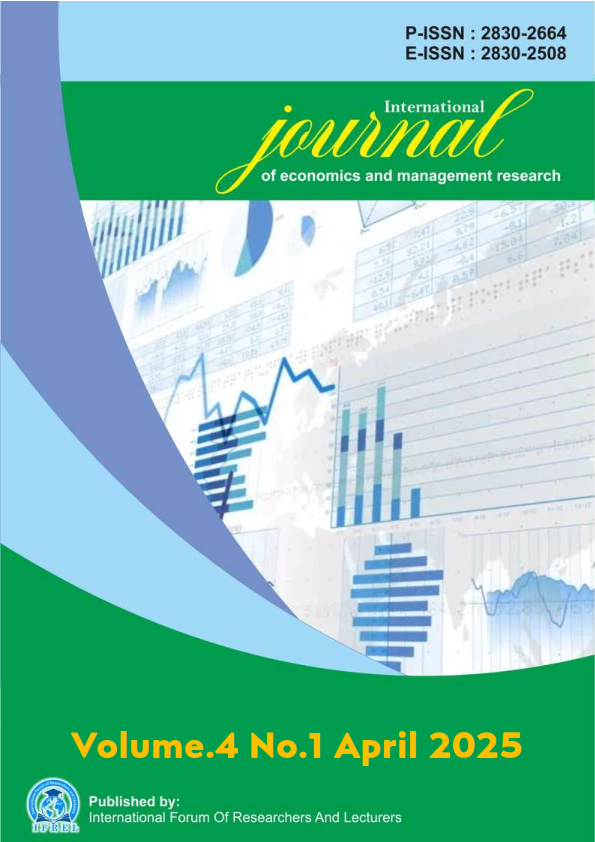Emotional Branding and Customer Loyalty: Gen Z in Japan and Indonesia
DOI:
https://doi.org/10.55606/ijemr.v4i1.492Keywords:
emotional branding, customer loyalty, Generation Z, digital consumer behavior, brand storytellingAbstract
Global brands increasingly struggle to retain Generation Z consumers who demand emotionally resonant and culturally relevant brand experiences. In Japan, where emotional restraint and symbolic messaging dominate consumer-brand interactions, Gen Z tends to bond with brands through aesthetics, storytelling, and quiet symbolism. Meanwhile, in Indonesia, Gen Z consumers exhibit high emotional expressiveness and loyalty to brands that foster social connection, authenticity, and community engagement. This paper analyzes how emotional branding mechanisms—such as brand love, emotional attachment, and self-congruity—function differently across these cultural settings. It reveals that while Japanese Gen Z responds to minimalist branding with embedded cultural cues, their Indonesian counterparts engage more with emotionally charged narratives and influencer-driven content. These distinctions offer practical insights for tailoring emotional branding to fit not only cultural norms but also platform-specific behaviors, such as Instagram aesthetics in Japan and TikTok virality in Indonesia. The study contributes actionable strategies for brands aiming to sustain loyalty among Gen Z in culturally diverse Asian markets.
References
Aaker, J. (1997). Dimensions of brand personality. Journal of Marketing Research, 34(3), 347–356. https://doi.org/10.2307/3151897
Albert, N., & Merunka, D. (2013). The role of brand love in consumer–brand relationships. Journal of Consumer Marketing, 30(3), 258–266. https://doi.org/10.1108/07363761311328928
Albert, N., Merunka, D., & Valette-Florence, P. (2013). Brand passion: Antecedents and consequences. Journal of Business Research, 66(7), 904–909. https://doi.org/10.1016/j.jbusres.2011.12.009
Batra, R., Ahuvia, A., & Bagozzi, R. P. (2012). Brand love. Journal of Marketing, 76(2), 1–16. https://doi.org/10.1509/jm.09.0339
Bergkvist, L., & Bech-Larsen, T. (2010). Two studies of consequences and actionable antecedents of brand love. Journal of Brand Management, 17(7), 504–518. https://doi.org/10.1057/bm.2010.6
Bian, Q., & Forsythe, S. (2012). Purchase intention for luxury brands: A cross cultural comparison. Journal of Business Research, 65(10), 1443–1451. https://doi.org/10.1016/j.jbusres.2011.10.010
Carroll, B. A., & Ahuvia, A. C. (2006). Some antecedents and outcomes of brand love. Marketing Letters, 17(2), 79–89. https://doi.org/10.1007/s11002-006-4219-2
de Mooij, M., & Hofstede, G. (2010). The Hofstede model: Applications to global branding and advertising strategy and research. International Journal of Advertising, 29(1), 85–110. https://doi.org/10.2501/s026504870920104x
Dessart, L., Veloutsou, C., & Morgan-Thomas, A. (2015). Consumer engagement in online brand communities: A social media perspective. Journal of Product & Brand Management, 24(1), 28–42. https://doi.org/10.1108/JPBM-06-2014-0635
Djafarova, E., & Bowes, T. (2021). “Instagram made me buy it”: Generation Z impulse purchases in fashion industry. Journal of Retailing and Consumer Services, 59, 102345. https://doi.org/10.1016/j.jretconser.2020.102345
Dwivedi, A., Johnson, L. W., Wilkie, D. C., & De Araujo-Gil, L. (2019). Consumer emotional brand attachment with social media brands and social media brand equity. European Journal of Marketing, 53(6), 1176–1204. https://doi.org/10.1108/EJM-09-2016-0511
Eren-Erdogmus, I., & Cicek, M. (2012). The impact of social media marketing on brand loyalty. Procedia - Social and Behavioral Sciences, 58, 1353–1360. https://doi.org/10.1016/j.sbspro.2012.09.1119
Fetscherin, M., & Heinrich, D. (2015). Consumer brand relationships research: A bibliometric citation meta-analysis. Journal of Business Research, 68(2), 380–390. https://doi.org/10.1016/j.jbusres.2014.06.010
Gensler, S., Völckner, F., Liu-Thompkins, Y., & Wiertz, C. (2013). Managing brands in the social media environment. Journal of Interactive Marketing, 27(4), 242–256. https://doi.org/10.1016/j.intmar.2013.09.004
Guèvremont, A., & Grohmann, B. (2013). The brand authenticity effect: Situational and individual-level moderators. European Journal of Marketing, 47(10), 1942–1962. https://doi.org/10.1108/EJM-10-2011-0533
Hall, E. T. (1976). Beyond culture. Anchor Books.
Hidayat, A., & Haryanto, J. O. (2010). Consumer attitude toward celebrity endorsement and brand equity of the product (a study in the Indonesian telecommunication industry). Journal of Management and Marketing Research, 5, 1–11.
Hofstede, G. (2001). Culture’s consequences: Comparing values, behaviors, institutions, and organizations across nations (2nd ed.). Sage.
Hollebeek, L. D., & Macky, K. (2019). Digital content marketing’s role in fostering consumer engagement, trust, and value: Framework, fundamental propositions, and implications. Journal of Interactive Marketing, 45, 27–41. https://doi.org/10.1016/j.intmar.2018.07.003
Islam, J. U., & Rahman, Z. (2016). Examining the effects of brand love and brand image on customer engagement: An empirical study of fashion apparel brands. Journal of Global Fashion Marketing, 7(1), 45–59. https://doi.org/10.1080/20932685.2015.1110041
Japutra, A., Ekinci, Y., & Simkin, L. (2014). Exploring brand attachment, its determinants and outcomes. Journal of Strategic Marketing, 22(7), 616–630. https://doi.org/10.1080/0965254X.2014.914062
Junaid, M., Hou, F., Hussain, K., & Kirmani, A. A. (2022). Brand love and word of mouth: The mediating role of brand loyalty. Journal of Consumer Behaviour, 21(1), 14–23. https://doi.org/10.1002/cb.1947
Keller, K. L. (2001). Building customer-based brand equity: A blueprint for creating strong brands. Marketing Management, 10(2), 15–19.
Kemp, E., Williams, K. H., & Neale, L. (2022). Emotional branding in the digital age: The impact of online brand experience on Gen Z brand relationships. Journal of Business Research, 139, 889–899. https://doi.org/10.1016/j.jbusres.2021.10.043
Kim, H., & Zhang, Y. (2021). Cultural differences in emotional branding: A meta-analysis. International Journal of Consumer Studies, 45(4), 591–608. https://doi.org/10.1111/ijcs.12653
Langner, T., Schmidt, J., & Fischer, A. (2015). Is it really love? A comparative investigation of the emotional nature of brand and interpersonal love. Psychology & Marketing, 32(6), 624–634. https://doi.org/10.1002/mar.20805
Lim, H., & Ang, S. H. (2019). When brands cross borders: Understanding the impact of cultural orientation on customer-brand relationships. International Marketing Review, 36(2), 260–282. https://doi.org/10.1108/IMR-12-2016-0225
Loureiro, S. M. C., Ruediger, K. H., & Demetris, V. (2012). Brand experience, brand attachment and brand loyalty: A comparison of generational cohorts. Journal of Retailing and Consumer Services, 19(1), 107–114. https://doi.org/10.1016/j.jretconser.2011.10.003
Malär, L., Krohmer, H., Hoyer, W. D., & Nyffenegger, B. (2011). Emotional brand attachment and brand personality: The relative importance of the actual and the ideal self. Journal of Marketing, 75(4), 35–52. https://doi.org/10.1509/jmkg.75.4.35
Nguyen, T. N. (2021). Brand affect and customer loyalty: An empirical study of Generation Z. Asia Pacific Journal of Marketing and Logistics, 33(9), 1903–1922. https://doi.org/10.1108/APJML-07-2020-0511
Park, C. W., Eisingerich, A. B., & Park, J. W. (2013). Attachment-aversion (AA) model of customer-brand relationships. Journal of Consumer Psychology, 23(2), 229–248. https://doi.org/10.1016/j.jcps.2013.01.002
Phan, M., Thomas, R., & Heine, K. (2011). Social media and luxury brand management: The case of Burberry. Journal of Global Fashion Marketing, 2(4), 213–222. https://doi.org/10.1080/20932685.2011.10593092
Priporas, C.-V., Stylos, N., & Fotiadis, A. K. (2017). Generation Z consumers’ expectations of interactions in smart retailing. Journal of Retailing and Consumer Services, 34, 281–289. https://doi.org/10.1016/j.jretconser.2016.10.006
Rachmawati, D., & Prabowo, H. (2021). Personalization in emotional branding: Enhancing loyalty in Gen Z Indonesian consumers. Asian Journal of Business Research, 11(2), 114–130. https://doi.org/10.14707/ajbr.210101
Rahman, M. M., & Areni, C. S. (2016). The influence of brand usage on perceptions of brand loyalty. Asia Pacific Journal of Marketing and Logistics, 28(4), 643–660. https://doi.org/10.1108/APJML-05-2015-0071
Schouten, J. W., McAlexander, J. H., & Koenig, H. F. (2007). Transcendent customer experience and brand community. Journal of the Academy of Marketing Science, 35(3), 357–368. https://doi.org/10.1007/s11747-007-0034-4
Seyedghorban, Z., Tahernejad, H., & Matanda, M. J. (2016). Reinquiry into advertising avoidance on the Internet: A conceptual replication and extension. Journal of Advertising, 45(1), 120–129. https://doi.org/10.1080/00913367.2015.1085819
So, J. T., Parsons, A. G., & Yap, S.-F. (2019). Corporate branding, emotional attachment and brand loyalty: The case of luxury fashion branding. Australasian Marketing Journal, 27(3), 190–199. https://doi.org/10.1016/j.ausmj.2019.05.003
Sugiyama, K., & Andree, J. (2011). Brand romance: Building consumer–brand relationships. Journal of Consumer Marketing, 28(1), 2–10. https://doi.org/10.1108/07363761111101930
Takahashi, K., & Ishida, Y. (2022). Mobile branding in Japan: Emotion, aesthetics, and loyalty in Gen Z. Asia Pacific Journal of Marketing and Logistics, 34(5), 987–1002. https://doi.org/10.1108/APJML-07-2021-0492
Thomson, M., MacInnis, D. J., & Park, C. W. (2005). The ties that bind: Measuring the strength of consumers’ emotional attachments to brands. Journal of Consumer Psychology, 15(1), 77–91. https://doi.org/10.1207/s15327663jcp1501_10
Tifferet, S., & Vilnai-Yavetz, I. (2018). Gender differences in brand commitment, impulse buying, and hedonic consumption. Journal of Product & Brand Management, 27(3), 235–245. https://doi.org/10.1108/JPBM-02-2017-1417
Utami, H. N. (2022). Interpersonal harmony and emotional expression among Indonesian Gen Z: An intercultural insight. International Journal of Intercultural Relations, 87, 90–101. https://doi.org/10.1016/j.ijintrel.2021.12.003
Veloutsou, C., & Guzmán, F. (2017). The evolution of brand management thinking over the last 25 years as recorded in the Journal of Product and Brand Management. Journal of Product & Brand Management, 26(1), 2–12. https://doi.org/10.1108/JPBM-01-2017-1398
Vernuccio, M., Pagani, M., Barbarossa, C., & Pastore, A. (2015). Antecedents of brand love in online network-based communities: A social identity perspective. Journal of Product & Brand Management, 24(7), 706–719. https://doi.org/10.1108/JPBM-06-2015-0909
Wallace, E., Buil, I., & de Chernatony, L. (2014). Consumer engagement with self-expressive brands: Brand love and WOM outcomes. Journal of Product & Brand Management, 23(1), 33–42. https://doi.org/10.1108/JPBM-06-2013-0326
Williams, K. C., Page, R. A., Petrosky, A. R., & Hernandez, E. H. (2021). Marketing to the generations: A new framework for understanding generational differences. Journal of Behavioral Studies in Business, 14, 1–12.
Yim, C. K., Tse, D. K., & Chan, K. W. (2008). Strengthening customer loyalty through intimacy and passion: Roles of customer–firm affection and customer–staff relationships in services. Journal of Marketing Research, 45(6), 741–756. https://doi.org/10.1509/jmkr.45.6.741
Yoo, B., Donthu, N., & Lenartowicz, T. (2011). Measuring Hofstede’s five dimensions of cultural values at the individual level: Development and validation of CVSCALE. Journal of International Consumer Marketing, 23(3–4), 193–210. https://doi.org/10.1080/08961530.2011.578059
Zarantonello, L., & Schmitt, B. H. (2013). The impact of event marketing on brand equity: The mediating roles of brand experience and brand attitude. International Journal of Advertising, 32(2), 255–280. https://doi.org/10.2501/IJA-32-2-255-280
Zarantonello, L., Romani, S., Grappi, S., & Bagozzi, R. P. (2018). Brand hate. Journal of Product & Brand Management, 27(1), 13–26. https://doi.org/10.1108/JPBM-06-2016-1244
Downloads
Published
How to Cite
Issue
Section
License
Copyright (c) 2025 International Journal of Economics and Management Research

This work is licensed under a Creative Commons Attribution-ShareAlike 4.0 International License.







